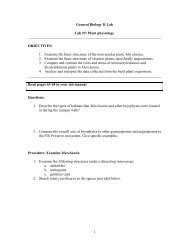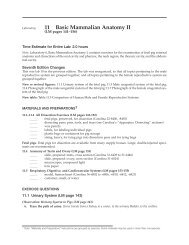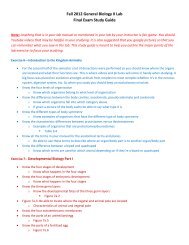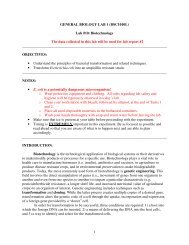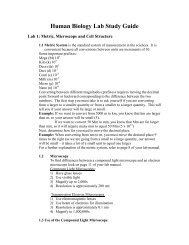Exercise 3: Membranes
Exercise 3: Membranes
Exercise 3: Membranes
You also want an ePaper? Increase the reach of your titles
YUMPU automatically turns print PDFs into web optimized ePapers that Google loves.
14. What reasons can you provide for the movement of these molecules across the membraneand not others?Task 4 - DIFFUSION OF GASESGas molecules are perpetually in random, rapid motion. Thus, they diffuse through any container veryquickly. For instance, when a bottle of cologne is opened up in a room, the fragrance can quickly besmelled throughout the entire room. The rate of gas diffusion is very much dependent on the molecularweight of the gas being used. With the experimental setup in front of you it is possible to determine effectof molecular weight on the diffusion of gases. If concentrated HCl is introduced at one end of a glass tubeand NH 4 OH at the other, the gases, HCl and NH 3 , diffuse toward the center. HCl has a molecular weightof 36 and NH 3 a molecular weight of 17. When both gases meet, they form NH 4 Cl, a white salt (not agas) that precipitates as a ring in the tube.Procedure:1. Remove the stoppers and simultaneously dip one swab in concentrated HCl and the other inconcentrated NH 4 OH.2. Reinsert the stoppers back into the tube at the same time.3. Observe the formation of a white ring of NH 4 Cl.Formulate scientific, null and alternative hypotheses describing which gas should move fasterand why? State each in the space provided below.Scientific:H o:H a:NOTE: This procedure will be demonstrated by your TA.CAUTION:• HCl is a concentrated acid and can harm you and your clothes.• NH 4OH is very irritating to the eyes and nose.10



